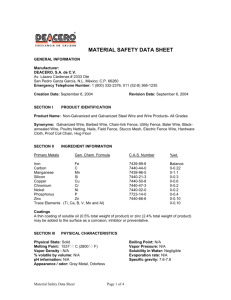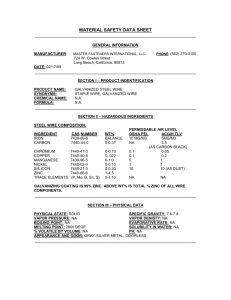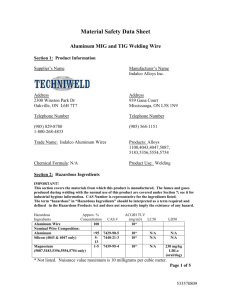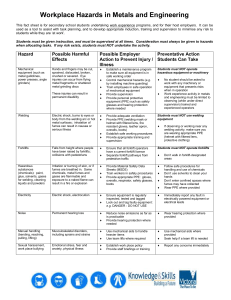CROWN ALLOYS MATERIAL SAFETY DATA SHEET COMPANY
advertisement
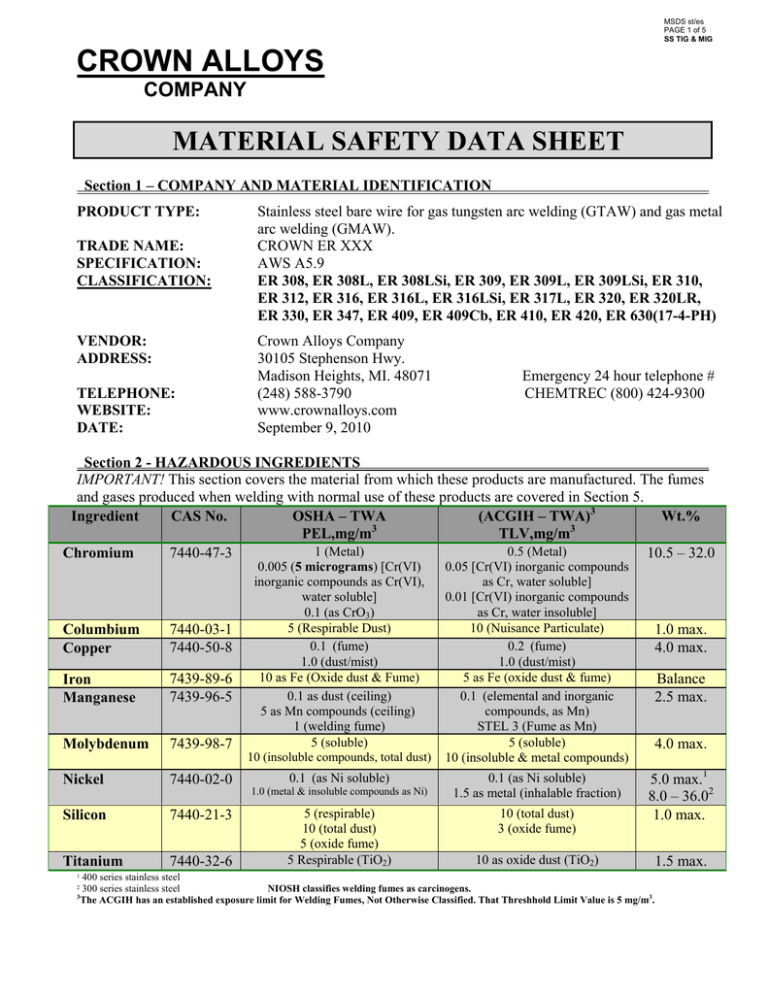
MSDS st/es PAGE 1 of 5 SS TIG & MIG CROWN ALLOYS COMPANY MATERIAL SAFETY DATA SHEET Section 1 – COMPANY AND MATERIAL IDENTIFICATION PRODUCT TYPE: TRADE NAME: SPECIFICATION: CLASSIFICATION: VENDOR: ADDRESS: TELEPHONE: WEBSITE: DATE: Stainless steel bare wire for gas tungsten arc welding (GTAW) and gas metal arc welding (GMAW). CROWN ER XXX AWS A5.9 ER 308, ER 308L, ER 308LSi, ER 309, ER 309L, ER 309LSi, ER 310, ER 312, ER 316, ER 316L, ER 316LSi, ER 317L, ER 320, ER 320LR, ER 330, ER 347, ER 409, ER 409Cb, ER 410, ER 420, ER 630(17-4-PH) Crown Alloys Company 30105 Stephenson Hwy. Madison Heights, MI. 48071 (248) 588-3790 www.crownalloys.com September 9, 2010 Emergency 24 hour telephone # CHEMTREC (800) 424-9300 Section 2 - HAZARDOUS INGREDIENTS IMPORTANT! This section covers the material from which these products are manufactured. The fumes and gases produced when welding with normal use of these products are covered in Section 5. Ingredient CAS No. OSHA – TWA (ACGIH – TWA)3 Wt.% 3 3 PEL,mg/m TLV,mg/m 1 (Metal) 0.5 (Metal) 7440-47-3 10.5 – 32.0 Chromium Columbium Copper 7440-03-1 7440-50-8 Iron Manganese 7439-89-6 7439-96-5 Molybdenum 7439-98-7 Nickel 7440-02-0 0.005 (5 micrograms) [Cr(VI) inorganic compounds as Cr(VI), water soluble] 0.1 (as CrO3) 5 (Respirable Dust) 0.1 (fume) 1.0 (dust/mist) 10 as Fe (Oxide dust & Fume) 0.1 as dust (ceiling) 5 as Mn compounds (ceiling) 1 (welding fume) 5 (soluble) 10 (insoluble compounds, total dust) 0.05 [Cr(VI) inorganic compounds as Cr, water soluble] 0.01 [Cr(VI) inorganic compounds as Cr, water insoluble] 10 (Nuisance Particulate) 0.2 (fume) 1.0 (dust/mist) 5 as Fe (oxide dust & fume) 0.1 (elemental and inorganic compounds, as Mn) STEL 3 (Fume as Mn) 5 (soluble) 10 (insoluble & metal compounds) 0.1 (as Ni soluble) 0.1 (as Ni soluble) 1.5 as metal (inhalable fraction) 1.0 (metal & insoluble compounds as Ni) Silicon 7440-21-3 Titanium 7440-32-6 5 (respirable) 10 (total dust) 5 (oxide fume) 5 Respirable (TiO2) 10 (total dust) 3 (oxide fume) 1.0 max. 4.0 max. Balance 2.5 max. 4.0 max. 5.0 max.1 8.0 – 36.02 1.0 max. 10 as oxide dust (TiO2) 400 series stainless steel 2 300 series stainless steel NIOSH classifies welding fumes as carcinogens. 3 The ACGIH has an established exposure limit for Welding Fumes, Not Otherwise Classified. That Threshhold Limit Value is 5 mg/m3. 1 1.5 max. MSDS st/es PAGE 2 of 5 SS TIG & MIG CROWN ALLOYS COMPANY Section 2 - HAZARDOUS INGREDIENTS (continued) HMIS RATING (Hazardous Materials Information System) Health (blue) - 2 Flammability (red) - 0 Protective Equipment - X Reactivity (yellow) - 0 (See Section 7) Health Hazard: 0 (minimal acute or chronic exposure hazard); 1 (slight acute or chronic exposure hazard); 2 (moderate acute or significant chronic exposure hazard); 3 (severe acute exposure hazard; one time overexposure can result in permanent injury and may be fatal); 4 (extreme acute exposure hazard; onetime overexposure can be fatal). Flammability Hazard: 0 (minimal hazard); 1 (materials that require substantial pre-heating before burning); 2 (combustible liquid or solids; liquids with a flash point of 38-93oC [100-200oF]); 3 (Class IB and IC flammable liquids with flash points below 38oC [100oF]); 4 (Class IA flammable liquids with flash points below 23oC [73oF] and boiling points below 38oC [100oF]. Reactivity Hazard: 0 (normally stable); 1 (material that can become unstable at elevated temperatures or which can react slightly with water); 2 (materials that are unstable but do not detonate or which can react violently with water); 3 (materials that can detonate when initiated or which can react explosively with water); 4 (materials that can detonate at normal temperatures or pressures). Caution: HMIS® ratings are based on a 0-4 rating scale, with 0 representing minimal hazards or risks, and 4 representing significant hazards or risks. Although HMIS® ratings are not required on MSDS's under 29 CFR 1910.1200, the preparer may choose to provide them. HMIS® ratings are to be used only in conjunction with a fully implemented HMIS® program by workers who have received appropriate HMIS® training. HMIS® is a registered trade and service mark of the NPCA. Section 3 - PHYSICAL and CHEMICAL CHARACTERISTICS Solid chrome-nickel welding consumables consisting of solid wire of various diameters, odorless. As shipped, these products are non-flammable, non-explosive, non-reactive and non-hazardous. Section 4 - FIRE and EXPLOSION HAZARD DATA NATIONAL FIRE PROTECTION ASSOCIATION: Health Hazard: 0 (material that on exposure under fire conditions would offer no hazard beyond that of ordinary combustible materials); 1 (materials that on exposure under fire conditions could cause irritation or minor residual injury); 2 (materials that on intense or continued exposure under fire conditions could cause temporary incapacitation or possible residual injury); 3 (materials that can on short exposure cause serious temporary or residual injury); 4 (materials that under very short exposure causes death or major residual injury). Flammability Hazard: Refer to definitions for "HMIS RATING (Hazardous Materials Information System)" Reactivity Hazard: Refer to definitions for "HMIS RATING (Hazardous Materials Information System)" NFPA RATING FLAMMABILITY 0 HEALTH 2 0 REACTIVITY OTHER FLAMMABLE PROPERTIES: Non-flammable as shipped. Brazing flame, welding arc and sparks can ignite combustibles and flammables. Refer to American National Standard Z49.1 “Safety in Welding and Cutting” and “Safe Practices” Code: SP, published by the American Welding Society for fire prevention during the use of welding, brazing and allied procedures. FLAMMABLE LIMITS (in air by volume, %): Lower (LEL): Not Applicable Upper (UEL): Not Applicable FLASH POINT: Not Flammable AUTOIGNITION TEMPERATURE: Not Flammable FIRE EXTINGUISHING MATERIALS: Water Spray: YES / Carbon Dioxide: YES / Halon: YES / Foam: YES / Dry Chemical: YES Other: Any “ABC” Class UNUSUAL FIRE AND EXPLOSION HAZARDS: When involved in a fire, this product may generate irritating fumes containing iron compounds, metal oxides and a variety of metal compounds. The molten material can present a significant thermal hazard to firefighters. MSDS st/es PAGE 3 of 5 SS TIG & MIG CROWN ALLOYS COMPANY Section 5 - REACTIVITY DATA Hazardous Decomposition Products These stainless steel alloys are stable under normal conditions of use, storage, and transportation as shipped. Welding fumes and gases can not be classified simply. The composition and quantity of both are dependent upon the metal being welded, coatings on the metal being welded (such as paint, plating, or galvanizing), the number of welders, the volume of the work area, the quality and the amount of ventilation, the position of the welder's head with respect to the gas plume, the presence of contaminants in the atmosphere (such as chlorinated hydrocarbon vapors from cleaning and degreasing activities), the process and procedures, as well as the welding consumables. When the electrode/wire is consumed, the fume and gas decomposition products generated are different in percent and form from the ingredients listed in Section 2. Decomposition products of normal operation include those originating from the volatilization, reaction, or oxidation of the materials shown in Section 2, plus those from the base metal, coatings, etc., as noted above. Reasonably expected decomposition products from normal use of these products include a complex of the oxides of the materials listed in Section 2, as well as carbon monoxide, carbon dioxide, ozone (TLV 0.1 ppm ceiling and PEL 0.1 ppm), nitric oxide (TLV 25 ppm and PEL 25 ppm) and nitrogen dioxide (TLV 3, 5 ppm STEL and PEL 5 ppm ceiling). The fume limit for manganese, nickel and/or chromium may be reached before the general limit for welding fumes (TLV 5 mg/m3) is reached. A SIGNIFICANT AMOUNT OF THE CHROMIUM IN THE FUMES CAN BE HEXAVALENT CHROMIUM , ALSO KNOWN AS Cr(VI), WHICH HAS A VERY LOW EXPOSURE LIMIT OF 0.005 mg/m3 (5 µg/m3). EU RoHS (European Union Restriction of Hazardous Substances): These stainless steel welding alloys contain Chromium. During welding these alloys will produce Cr(VI) (hexavalent chromium), however, the weld deposit does not contain Cr(VI) as it will all be in the zero valent state or as Cr(III) as an oxide. FINISHED PRODUCTS MANUFACTURED USING THESE STAINLESS STEEL WELDING ALLOYS WILL NOT CONTAIN ANY Cr(VI). One recommended way to determine the composition and quantity of fumes and gases to which workers are exposed is to take an air sample inside the welder's helmet if worn or in the worker's breathing zone. See ANSI/AWS F1.1 "Method for Sampling Airborne Particles Generated by Welding and Allied Processes" and "Characterization of Arc Welding Fume" available from the American Welding Society, 550 N.W. LeJeune Road, Miami, FL 33126. Section 6 - HEALTH HAZARD DATA • • • • Medical conditions aggravated by exposure to this product: Chronic lung disease, skin rashes, and asthma. EYES: Welding fume can cause irritation. Chronic exposures could cause conjunctivitis. Ultraviolet radiation from welding can cause flash burns. SKIN: User generated dusts and fumes may produce mechanical irritation. Chronic exposures could cause dermatitis. Ultraviolet radiation and infrared heat rays from flames and hot metal can burn skin. INHALATION: Excessive inhalation of user generated fumes from high temperature cutting or welding of these alloys may, depending on the specific features of the process used, pose a long term health hazard. The IARC has concluded that welding fumes are possibly carcinogenic to humans. Some of the other health effects are listed below: ¾ Hexavalent chromium (Chrome VI) can cause asthma, kidney damage, primary irritant dermatitis, sensitization dermatitis, skin ulceration, and pulmonary edema (fluid in the lungs). Chronic inhalation or overexposure has been associated with lung, nasal, gastrointestinal cancer. Hexavalent chromium is listed as carcinogenic to humans by IARC (Group 1)*. Chromium and some of its compounds are listed as carcinogenic by the NTP. Hexavalent chromium compounds may be generated during welding operations with alloys containing chromium. ¾ Columbium also known as niobium could cause irritation to the respiratory tract upon acute exposure. ¾ Overexposure to copper fume may exist when welding, flame cutting, etc. Overexposure to copper dust/ mists can cause irritation of the eyes, skin, and upper respiratory tract. Chronic overexposure may result in blood disorders (anemia), and skin and hair discoloration. Overexposure to copper fume can result in respiratory tract irritation, nausea, fever, chills, shortness of breath and malaise (metal fume fever). ¾ Inhalation of excessive iron oxide fumes or dusts can lead to irritation of the respiratory tract. Prolonged in-halation of iron oxide for periods of 6 to 10 years is known to cause siderosis which appears to be a benign pneumoconiosis. MSDS st/es PAGE 4 of 5 SS TIG & MIG CROWN ALLOYS COMPANY Section 6 - HEALTH HAZARD DATA (continued) • • INHALATION (continued): Excessive inhalation of user generated fumes from high temperature cutting or welding of these alloys may, depending on the specific features of the process used, pose a long term health hazard. The IARC has concluded that welding fumes are possibly carcinogenic to humans. Some of the other health effects are listed below: ¾ Chronic exposure to high levels of manganese dust or fumes can cause nervous system disorders, pneumonitis (inflammation of lung tissue), and may cause fibrosis (scarring of lung tissue) and reproductive disorders in males. It can also lead to neurological problems such as apathy, drowsiness, weakness, spastic gait, paralysis and other neurological problems resembling Parkinsonism. Excessive inhalation of fumes may cause “Metal Fume Fever” with its flu like symptoms, such as chills, fever, body aches, vomiting & sweating. ¾ Inhalation of molybdenum fumes has caused kidney damage, respiratory irritation and liver damage in animals. ¾ The U.S. National Toxicology Program has listed nickel and seven nickel compounds as reasonably anticipated to be a carcinogen based on the production of injection-site tumors in experimental animals. Nickel compounds are listed as carcinogenic to humans by IARC (Group 1)*. Epidemiological studies of workers exposed to nickel powder and to dust and fume generated in the production of nickel alloys and of stainless steel have not indicated the presence of a significant respiratory cancer hazard. ¾ Oxides of nitrogen can cause irritation of the eyes, skin (when moist), and respiratory tract. Exposure to high levels of nitrogen oxides can cause delayed pulmonary edema (fluid in the lungs) which may be fatal. Nitric oxide can cause formation of methemoglobin, which decreases the blood’s ability to carry oxygen. Chronic overexposure can cause pulmonary fibrosis (scarring of the lungs). ¾ Welding processes generate fumes and an intense ultraviolet radiation that results in the formation of ozone and oxides of nitrogen. Exposure to low levels of ozone can cause irritation of the eyes, nose and throat. Inhalation can cause chest tightness, headache, shortness of breath, cough, wheeze and narrowing of airways. Symptoms disappear when removed from exposure. ¾ Exposure to high levels of ozone may cause acute respiratory distress with shortness of breath, pulmonary changes, hemorrhage and pulmonary edema (fluid in lungs). Symptoms of pulmonary edema may be delayed for one or more hours. Exposure of test animals and human tissue to high concentrations has shown chromosomal changes, reproductive effects, blood changes, and death from lung congestion. ¾ High concentrations of silicon dust will cause some irritation to the nose and throat. Inhalation of crystalline silica over a long period can cause silicosis. Crystalline silica is listed as carcinogenic to humans by IARC (Group 1)*. ¾ Inhalation of titanium could cause mild irritation to the respiratory tract. Inhalation of titanium dioxide dust or fume could produce lung fibrosis and chronic bronchitis. ¾ Shielding gases such as argon, helium and carbon dioxide are asphyxiants and adequate ventilation and/or respirators must be provided. *IARC CLASSIFICATIONS: Group 1: The agent is carcinogenic to humans. There is sufficient evidence that a causal relationship existed between exposure to the agent and human cancer. Section 7 - PRECAUTIONS FOR SAFE HANDLING & USE/APPLICABLE CONTROL MEASURES VENTILATION AND ENGINEERING CONTROLS: Maintain exposures below the acceptable exposure levels (see Section 2). Use industrial hygiene air monitoring to ensure that your use of these products does not create exposures that exceed the recommended exposure limits. Always use exhaust ventilation in user operations such as high temperature cutting, grinding, welding and brazing. Train the welder to keep his head out of the fume plume. Confined spaces require adequate ventilation and/or air supplied respirators. Read and understand the manufacturer's instructions and the precautionary label on the product. See American National Standard Z49.1, Safety in Welding, Cutting, and Allied Processes, published by the American Welding Society, 550 N.W. LeJeune Road, Miami, FL 33126 and OSHA Publication 2206 (29CFR1910), US Government Printing Office, Washington, D.C. 20402 for more details on many of the following. RESPIRATORY PROTECTION: Use respirable fume respirator or air supplied respirator when welding in confined space or where local exhaust or ventilation does not keep exposure below TLV’s (see Section 2). Use only NIOSH approved respirators in accordance with 29 CFR 1910.134 – Respiratory Protection. Oxygen levels below 19.5% are considered IDLH by OSHA. In such atmospheres, use of a full-facepiece pressure/demand SCBA or a full facepiece, supplied air respirator with auxiliary self-contained air supply is required under OSHA’s Respiratory Protection Standard (1910.134-1998). FOR MAXIMUM SAFETY: BE CERTIFIED FOR AND WEAR A RESPIRATOR AT ALL TIMES WHEN WELDING OR BRAZING! EYE PROTECTION: Ensure eyewash/safety shower stations are available near areas where these products are used. Wear safety glasses, goggles or face-shield with filter lens of appropriate shade number (per ANSI Z49.1-1988, “Safety in Welding and Cutting”). PROTECTIVE CLOTHING: Wear head, hand, and body protection which help to prevent injury from radiation, sparks, and electrical shock. See ANSI Z49.1. As a minimum this includes welder's gloves, protective face shield, dark substantial clothing, and may include arm protectors, aprons, hats, and shoulder protection. WORK PRACTICES AND HYGIENE PRACTICES: As with all chemicals, avoid getting these products ON YOU or IN YOU. Wash hands after handling these products. Do not eat or drink while handling these products. WASTE DISPOSAL METHOD: Prevent waste from contaminating surrounding environment. Discard any product, residue, disposable container or liner in an environmentally acceptable manner, in full compliance with federal, state and local regulations. However, alloy wastes are normally collected to recover metal values. MSDS st/es PAGE 5 of 5 SS TIG & MIG CROWN ALLOYS COMPANY Section 8 - FIRST AID MEASURES • • • • EYE EXPOSURE: Flush eyes with plenty of water or saline for at least 15 minutes. Consult a physician. SKIN EXPOSURE: Wash thoroughly with soap and water. If molten material contaminates the skin, immediately begin decontamination with cold, running water. Minimum flushing is for 15 minutes. Consult a physician if irritation persists. INHALATION EXPOSURE: Remove to fresh air. Check for clear airway, breathing and presence of pulse. Provide CPR for persons without pulse or respirations. Consult a physician immediately. INGESTION EXPOSURE: Ingestion is not a likely route of exposure for these rods. If swallowed CALL PHYSICIAN OR POISON CONTROL CENTER FOR MOST CURRENT INFORMATION. DO NOT INDUCE VOMITING, unless directed by medical personnel. Have victim rinse mouth with water, if conscious. Never induce vomiting or give diluents (milk or water) to someone who is unconscious, having convulsions, or unable to swallow. RECOMMENDATIONS TO PHYSICIANS: Treat symptoms and eliminate overexposure. Section 9 - TOXICOLOGICAL INFORMATION Below are the LD50 and the LC50 values available for some of the fumes and gases given off during welding: CARBON MONOXIDE: (Cas No. 630-08-0) IRON: MOLYBDENUM OXIDE: (CAS TDLo (oral, child) = 77 mg/kg;BAH gastrointestinal tract, blood effects No.18868-43-4) Cr (VI) OXIDE: (Cas No. 1333-82-0) LD50 (oral, rat) = 80 mg/kg IRON OXIDE: (CAS No. 1309-37-1) NICKEL OXIDE: (CAS No. 1313-99-1) COPPER OXIDE: (CAS No. 1317-39-1) LD50 (intraperitoneal, rat) = 5500 mg/kg LD50 (subcutaneous, mouse) = 50 mg/kg LD50 (oral, rat) = 470 mg/kg MANGANESE: OZONE: (CAS No. 10028-15-6) LC50 (inhalation, mouse) = 2444 ppm/4H • LD50 (oral, rat) = 125 mg/kg LC50 (inhalation, cat) = 34.5 ppm/3H TCLo (inhalation, man) =2300µg/m3 BRN, central nervous system effects SUSPECTED CANCER AGENT: The components of these products are listed as follows: ¾ IRON OXIDE: IARC Group 3 (Not Classifiable as to Carcinogenicity to Humans), ACGIH-TLV-A4 (Not Classifiable as a Human Carcinogen). ¾ MANGANESE: EPA-D (Not Classifiable as to Human Carcinogenicity) ¾ CARBON: IARC Group 3 (Not Classifiable as to Carcinogenicity to Humans). NIOSH-X (Carcinogen defined with no further categorization). ¾ NICKEL: Nickel compounds are listed on the NTP and are listed on IARC Group 1(The agent is carcinogenic to humans). Nickel metal is possibly carcinogenic to humans as defined by IARC Group 2B(The agent is possibly carcinogenic to humans). ¾ CHROMIUM: Hexavalent chromium is listed on IARC Group 1(The agent is carcinogenic to humans). Chromium and some of its compounds are listed as carcinogenic by the NTP. Section 10 – REGULATORY INFORMATION U.S. SARA REPORTING REQUIREMENTS: The components of these products are subject to the reporting requirements of Sections 302, 304 and 313 of Title III of the Superfund Amendments and Reauthorization Act, as follows: CHEMICAL NAME SARA 302 SARA 304 SARA 313 (40 CFR 355, Appendix A) (40 CFR Table 302.4) (40 CFR 372.65) No Yes Yes Chromium No No Yes Manganese No No Yes Vanadium (fume or dust) U.S. SARA THRESHOLD PLANNING QUANTITY: There are no specific Threshold Planning Quantities for the components of these products. The default Federal MSDS submission and inventory requirement filing threshold of 10,000 lbs (4,540 kg) therefore applies, per 40 CFR 370.20. CALIFORNIA PROPOSITION 65: WARNING: This product contains or produces a chemical known to the State of California to cause cancer and birth defects (or other reproductive harm). (California Health & Safety Code 25249.5 et seq.) Section 11 – DEFINITIONS OF TERMS CAS No. - Chemical Abstracts Service Number PEL - Permissible Exposure Level TLV - Threshold Limit Value TWA - Time Weighted Average STEL - Short Term Exposure Limit IARC – International Agency for Research on Cancer NIOSH – National Institute of Occupational Safety and Health OSHA – U.S. Occupational Safety and Health Administration TDLo – the lowest dose to cause a symptom TCLo – the lowest concentration to cause a symptom TDo, LDLo, and LDo, or TC, TCo, LCLo, and LCo – the lowest dose (or concentration) to cause lethal or toxic effects. SARA – Superfund Amendments and Reauthorization Act ACGIH – American Conference of Governmental Industrial Hygienists LD50 & LC50 – These values are the amount of a substance given to the stated species that causes 50% of that species to die. mppcf – Millions of Particles Per Cubic Foot DISCLAIMER OF EXPRESSED AND IMPLIED WARRANTIES: The information in this document is believed to be correct as of the date issued. However, this information is provided without any representation or warranty, expressed or implied, regarding accuracy or correctness. The conditions or methods of handling, storage, use and disposal of the product are beyond our control and may be beyond our knowledge. For this and other reasons we do not assume responsibility and expressly disclaim liability of loss, damage, or expense arising from it or any way connected with the handling, storage, use, or disposal of this product. Data may be changed from time to time. Be sure to consult the latest edition of the MSDS.

